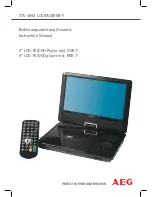
4000EXL Extended Life Generator
7
5A. For electric starting, press start switch on
generator cradle.To prolong the life of the starter
components, press the starter button for no more
than 15 seconds, and pause for 30 seconds.
5B. For manual starting, grasp the recoil handle and pull
slowly until slight resistance is felt.Then pull rapidly
one time only to start engine.
• If engine starts, proceed to step 7.
• If engine fails to start, proceed to step 6.
6.
Move the choke lever to “Half” choke position, and
press start button or pull recoil handle twice.
• If engine fails to start, repeat steps 4 thru 6.
7.
Move choke lever to “Run” position. If engine falters,
move choke lever to “Half” choke position until the
engine runs smoothly and then to “Run” position.
NOTE: If engine still fails to start after 3 pulls, check for
proper oil level in crankcase.This unit is equipped with a
Low Oil Shutdown System. See engine manual.
Refer to the engine owner’s manual for complete
starting instructions.
Connecting Electrical Loads
• Let engine stabilize and warm up for a few minutes after
starting.
• Plug in and turn on the desired 120 and/or 240 Volt AC,
single phase, 60 Hz electrical loads.
• Do Not connect 240 Volt loads to the 120 Volt
receptacles.
• Do Not connect 3–phase loads to the generator.
• Do Not connect 50 Hz loads to the generator.
• DO NOT OVERLOAD THE GENERATOR. See
“Don’t Overload the Generator” on page 10.
Stopping the Engine
• Unplug all electrical loads from generator panel
receptacles. Never start or stop engine with electrical
devices plugged in and turned on.
• Put the idle control switch in the “Off” position.
• Let engine run at no–load for 30 seconds to stabilize the
internal temperatures of engine and generator.
• Move run/stop switch to “Stop”.
• Close the fuel shut–off valve.
Operating Automatic Idle Control
This switch is designed to greatly improve fuel economy.
When this switch is turned ON, the engine will only
run at its normal high governed engine speed when an
electrical load is connected.When an electrical load is
removed, the engine will run at a reduced speed. With
the switch off, the engine will run at the normal high
engine speed. Always have the switch off when
starting and stopping the engine.
Charging a Battery
WARNING!
Storage batteries give off explosive
hydrogen gas while recharging. An explosive mixture
will remain around the battery for a long time after
it has been charged.The slightest spark can ignite
the hydrogen and cause an explosion, resulting in
blindness or other serious injury.
WARNING!
Do Not permit smoking, open
flame, sparks or any other source of heat around a
battery.Wear protective goggles, rubber apron and
rubber gloves when working around a battery.
Battery electrolyte fluid is an extremely caustic
sulfuric acid solution that can cause severe burns. If
spill occurs flush area with clear water immediately.
Your generator has the capability of recharging a
discharged 12 Volt automotive or utility style storage
battery. Do Not use the unit to charge any 6 Volt
batteries. Do Not use the unit to crank an engine having a
discharged battery.
To recharge 12 Volt batteries, proceed as follows:
• Check fluid level in all battery cells. If necessary, add
ONLY distilled water to cover separators in battery
cells. Do Not use tap water.
• If the battery is equipped with vent caps, make sure they
are installed and are tight.
• If necessary, clean battery terminals.
• Connect battery charge cable connector plug to panel
receptacle identified by the words “12-VOLTS D.C.”.
• Connect battery charge cable clamp with red handle to
the positive (+) battery terminal (Figure 8).
• Connect battery charge cable clamp with black handle
to the negative (–) battery terminal (Figure 8).






































